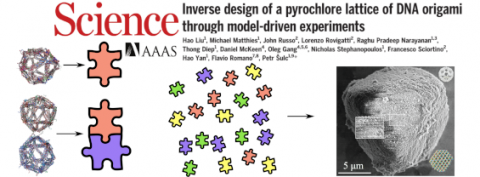Inverse design of a pyrochlore lattice of DNA origami through model-driven experiments

Sophisticated statistical mechanics approaches and human intuition have demonstrated the possibility of self-assembling complex lattices or finite-size constructs at the nanoscale.
However, attempts so far have mostly been successful in simulations, since they often fail in experiment because of unpredicted traps associated with kinetic slowing down (gelation, glass transition) and competing ordered structures.
Theoretical predictions also face the difficulty of encoding the desired interparticle interaction potential with the experimentally available nano- and micrometer-sized particles.
To overcome these issues, an international collaboration between three researchers of the department (Lorenzo Rovigatti, John Russo and Francesco Sciortino) and research teams of Ca' Foscari, Columbia and Arizona State University used a design algorithm based on constrained optimization, which they dubbed "SAT-assembly", with coarse-grained simulations of DNA nanotechnology to experimentally realize trap-free self-assembly pathways.
In the paper they published on the prestigious "Science" journal, they show that this approach can be used to assemble a pyrochlore three-dimensional lattice, coveted for its promise in the construction of optical metamaterials, by using DNA origami, and characterize it with small-angle x-ray scattering and scanning electron microscopy visualization.
Autori
Hao Liu, Michael Matthies, John Russo, Lorenzo Rovigatti, Raghu Pradeep Narayanan,Thong Diep, Daniel McKeen, Oleg Gang, Nicholas Stephanopoulos, Francesco Sciortino, Hao Yan, Flavio Romano, Petr Šulc
